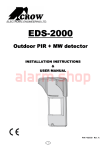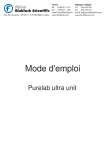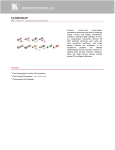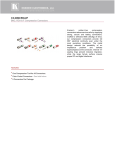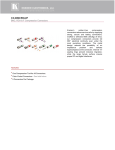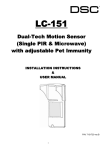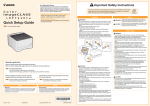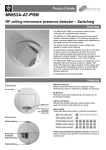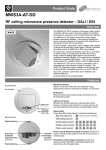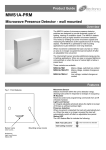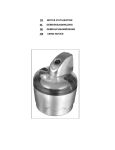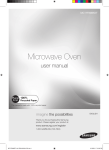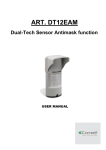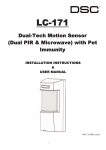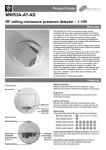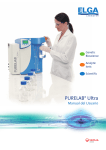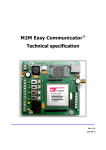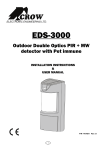Download LC-151
Transcript
LC-151 Dual-Tech Motion Sensor (Single PIR & Microwave) with adjustable Pet Immunity INSTALLATION INSTRUCTIONS & USER MANUAL P/N: 7131720 ver.B 1 1 General...................................................................................................................................... 3 2 Features .................................................................................................................................... 3 3 Assembly description................................................................................................................. 4 4 Detection Pattern....................................................................................................................... 5 5 Selecting mounting location....................................................................................................... 7 6 Detector Installation................................................................................................................... 8 7 Terminal Block Connections.................................................................................................... 10 7.1 8 9 Wire Size Requirements................................................................................................... 10 Settings & Adjustments ........................................................................................................... 11 8.1 Detection beam direction.................................................................................................. 11 8.2 Detection beam range setting .......................................................................................... 11 8.3 Sensitivity Adjustment ...................................................................................................... 11 8.4 Indications setting............................................................................................................. 12 Operation................................................................................................................................. 14 10 Test procedure ....................................................................................................................................... 14 11 Accessories............................................................................................................................................. 14 12 Specifications ......................................................................................................................................... 15 2 1 General The LC-151 is a unique motion detector utilizing a single (two elements) passive infra-red element and Microwave technology for use outdoors in harsh environments. The LC-151 is designed for outdoor use in the most severe and climatic conditions EN and may also accommodate pets with the addition of optional pet immunity lenses. High reliability is achieved by combining both dual tech hardware with highly sophisticated software, greatly reducing the possibility of false alarms. The active elements are comprised of a single (two elements) PIR and advanced Microwave detector inside a stylish, rigid plastic body. These special optics combined with a Microwave Doppler sensor assures elimination of “false alarms” while maintaining high security standards for the detection of human intruders into the protected area. The detection sensitivity and range is controlled by a potentiometer allowing fine tuning, so that the correct detection pattern will be set for every installation. The LC-151 is designed to protect large areas and can easily be installed on walls in order to provide a solid protection of the area while rejects interferences from birds and small animals due to the optional “PET MASK” optics. 2 Features ! Microwave detection based on Doppler concept. ! N.O. & N.C. relays switched at the same time. ! Installation height is calibration free from 1.8m to 2.4m (5.9 to 7.8 ft) ! Pet Immune up to 15kg (33lb) without pet immunity lens or up to 36kg (80lb) when using supplied LC-F1-15X pet immunity lens. ! PIR sensitivity adjustment. ! MW intensity selection. ! Temperature compensation. ! Microcontroller signal processing. ! Front and back tamper protection. ! Unique waterproof and sealed plastic design. ! Detection Range: Up to 15m (49 ft) ! Detects human intruders walking or running. ! No maintenance required. ! High RFI/EMI Immunity. ! Protection from: direct sunlight, wind up to 30 m/sec (98 ft/sec), snow and rain, small animals, removal of top cover and removal from mounting bracket. 3 3 Assembly description The LC-151 is a robust yet small detector which includes a large LED indicator that can be easily observed from long distances to provide indication of intrusion. Using the supplied mounting bracket, the LC-151 can be easily mounted to walls using the provided mounting screws. For installations requiring the detection beam to be adjusted horizontally or vertically to obtain the desired field of protection use the LC-B1-15X Outdoor Mounting Bracket pictured below. (not included) LC-151 Outdoor Motion Detector LC-B1-15X Outdoor Mounting Bracket The LC-151 consists of two detection elements: ! PIR element ! Microwave element The following drawing shows all internal elements: Microwave Doppler Detection LEDS Microwave intensity control jumper (Factory setting: ON) Detection LED control jumper (Factory setting: ON) Sensitivity setting Tamper switch Terminal Connection Block 4 4 Detection Pattern The LC-151 has a 90° top view PIR and MW detection pattern with over 15m (49 ft) detection distance (when installed at 2.4m (7.8 ft) above the ground surface). EN Standard Lens 5 LC-L1-15X Corridor Lens (sold separately) The LC-151 can differentiate between pets and human bodies and alert accordingly by utilizing microwave movement detection combined with a PIR detection beam. An intrusion is defined by the PIR detection beam being crossed and a microwave detection occurring, causing an alarm. No alarm will be generated if only the PIR detection beam is crossed or if only a microwave detection occurs. 6 5 Selecting mounting location The installation of the LC-151 requires a solid, level base for the mounting bracket and must be located in a manner that when the detector is mounted, it is facing the center of the EN desired detection zone. It is recommended that the detector will face a solid border limiting the detection area, such as the building structure or fencing wall, to avoid undesired detection range. The protected area must be free from obstacles like walls, fences, trees, ditches and other microwave detectors. Choose a location most likely to intercept an intruder according to detection pattern on page 5. Avoid the following Installation Locations: ! Facing direct sunlight. ! Facing areas subject to rapid temperature changes. ! Mounted at more than 10º from the vertical or horizontal plane. ! Facing metal doors. ! Near direct sources of heat or airflow. ! Clear all physical obstacles from the detection area (e.g. plants, laundry, etc.) ! Clear all light reflecting surfaces from the detection area, including puddles or other standing water. ! Avoid installation on the following types of ground: Thick vegetation, Grass (un-mown), Water, Sand and Metal. NOTES: ! Recommended installation height is 2.1m (6.8 ft). ! The PIR sensor detects motion crossing the beam; it is less sensitive detecting motion towards the detector. ! The LC-151 performs best when provided with a constant and stable environment. ! In order to ensure suitable operation of the LC-151, the type of ground should be one of the following: Asphalt concrete, Cement, Soil, Clay, Gravel or Grass (mown). ! Sensitivity adjustment may be required upon extreme temperature changes. Extremely high temperature will reduce detection range. Extremely low temperature will increase detection range. Choose proper installation location to avoid resetting. 7 6 Detector Installation Important! Prior to installation, read both “Operation” and “Selecting the mounting location” sections carefully. 1. Install the detector in such manner that the intruder is 2. The detector is to be installed at height of 1.8 to 2.4 most likely to cross the detection area from side to side. meters (5.9 to 7.8 ft) , ideally 2.1m (6.8 ft) 3. Make sure to attach the metal bracket to a leveled 4. Placing the detector on perpendicular wall is straight and firm wall, leaving 10cm (3.9 inches) from required for guarding a side window opening. the top and 10cm (3.9 inches) from both sides, for easy Alternately the LC-B1-15X Outdoor Mounting bracket installation and maintenance. can be installed on the same wall, allowing the detector beam to be rotated towards the window. 5. Open the detector unwinding the bottom screw. 6. Release the rear metal bracket by unwinding internal bottom screw. 8 7. Release the detector body from the metal bracket by 8. Attach the rear bracket to the wall using mounting pulling the detector up and out. screws. 9. Insert wires through provided access hole and wiring 10. Attach the sealing sponge pad to the wire opening channels. from the rear side after the wires have been connected and prior to final product affixing to the mounted bracket. 11. Place the detector on the mounting bracket from top 12. If Pet immunity up to 15kg (33lb) is desired do not side down and then lock the screw at the bottom. install the LC-F1-15X mechanical pet filter. If Pet immunity up to 36kg (80lb) is desired install the LC-F1-15X mechanical pet filter. 9 7 Terminal Block Connections Terminal 1 - Marked “+” (+12V) - Connect to a positive Voltage of 9.6 -16Vdc source (usually from the control panel) Terminal 2 - Marked “-” (GND) - Connect to the ground of the control panel. Terminals 3 & 4 - Marked “TAMPER” - If a Tamper function is required connect these Terminals to a normally closed 24-Hour Tamper Zone on the control panel. If the top cover of the detector is opened or the detector is detached from installation wall, an immediate alarm signal will be sent to the control panel. Terminal 5 - Marked “EOL” - End of line – optional terminal for end of line resistors connections. Terminals 6, 7 & 8 - Marked “NC / C / NO” - These are the output relay contacts of the detector. Connect to a zone input on the control panel. When an intruder is detected, alarm relays (N.C. and N.O.) will switch for 1.8 sec. 7.1 Wire Size Requirements Use #22 AWG or larger wires. Use the following table to determine required wire gauge and length. Wire Length [m] 205 310 510 870 Wire Length [ft.] 800 1200 2000 3400 Wire Gauge [#] 22 20 18 16 10 8 Settings & Adjustments 8.1 Detection beam direction The LC-151 detection beam direction is fixed. As a result, it is recommended to EN face the intrusion area with the detector. 8.2 Detection beam range setting The detection range may be set by tilting the detector while installed using the LC-B1-15X Outdoor Mounting Bracket. The range may vary between 5 and 15m (16ft to 49ft). 8.3 Sensitivity Adjustment The calibration of detector sensitivity is performed by a single sensitivity potentiometer and a Microwave intensity jumper. Changing the PIR sensitivity and microwave intensity affects immunity to environmental noises and allows the detector to operate without nuisance alarms in noisier environments. The microwave intensity jumper is marked with "H" (high) and "L" (low) settings. The sensitivity potentiometer is marked with "-" to "+". Position "-" is the minimum sensitivity and position "+" is the maximum sensitivity. The PIR sensitivity and microwave intensity must be adjusted according to environmental conditions as follows: Sensitivity Potentiometer MW intensity setting 11 Environment type Potentiometer position MW jumper position Low risk At position 5 H Risk Between positions H 3 and 4 High risk Between positions L 4 and 5 Very high risk Between positions L 3 and 4 Noisy area Between positions L 2 and 3 Extremely Noisy area At position 1 L Note: Adjust sensitivity according to environmental conditions! ! Low risk: very stable environment without interference from parking garages, parking space, playgrounds, football fields, service roads, etc. ! Risk: Stable environment with some trees, bushes, flowerpots, planters, etc. ! High risk: Unstable environment with different types of vegetation and grass and puddles. ! Very high risk: Unstable environment with winds and small pets, rats, mice, birds. ! Noisy area: Unstable environment with vegetation and water sources like swimming pool, lake, canal, weeds as well as small pets like cats and rabbits. ! Extremely Noisy area: Very unstable environment subjected to wind, snow, rain, with vegetation, water and large pets like dogs. For Example: If the detector is used in a space which contains several bushes and a swimming pool the environmental conditions should be considered a "Noisy Area" 8.4 Indications setting The LC-151 has 3 LEDs that each points at different indication: 1. Green LED indicates PIR detection. 2. Yellow LED indicates Microwave detection. 3. Red LED – Indicates an alarm (logic AND of both Mircowave and PIR). 12 When the LED jumper is in the "ON" position the LEDs will be active. When the LED jumper is in the "OFF" position, the LEDs will not activate. EN Detection LEDs LEDs Control jumper (Factory setting: ON) ! Place the top cover to the base and close it using the bottom screw. ! Place the top visor in place. 13 9 Operation Note! Connect the LC-151 to a positive Voltage output of 9.6 -16Vdc source. Use only a listed power limited source. The detector shall be provided with minimum of 4 hours of standby power from either a listed compatible control unit or power supply. ! The detector begins a 30 second warm up period once connected to power. ! If the LEDs are enabled, they will sequentially flash from left to right for the duration of the 30 seconds warm up period. ! Once the warm up period is complete, the detector is ready for use. 10 Test procedure Walk Test IMPORTANT NOTE: Once installed, the unit should be thoroughly tested to verify proper operation and coverage. After installation, the unit should be tested annually by the installer. The end user should be instructed on how to perform a weekly walk test. Make sure LEDs control is set to “ON” Ensure the detector has completed the 30 second warm up period before walk testing. Make sure that the protected area is cleared of all people. Create motion in the entire area where coverage is desired by walking perpendicular to the detection pattern. Look at the LEDs whenever motion is detected - all LEDs are turned ON. Allow 5 sec. between each test for the detector to stabilize. Walk across the entire area where coverage is desired. Should the coverage be incomplete, readjust sensitivity or relocate the detector. Once coverage is as desired the LEDs should be disabled. 11 Accessories Device Outdoor Mounting bracket PIR Corridor/Long Range Lens 36kg (80lb) PET Filter Part Number LC-B1-15X LC-L1-15X LC-F1-15X 14 12 Specifications Detection Method Microwave Frequency Power Input Current Draw Temp Compensation Alarm Period RF Immunity PIR AND MW X-band (9.9GHz / 10.525GHz / 10.687GHz) 9.6 to 16Vdc Active: 24mA (±5%); Standby: 21mA (±5%) Dual slope temperature compensation 2 sec (±0.5sec) Form C (NC, NO, Common) 28Vdc 0.1 A with 10 Ohm Two Switches N.C 28Vdc 0.1 A with 10 Ohm Series protection resistors Opens when cover is removed from unit’s base or if base is removed from wall 30sec (± 5sec) Green LED for PIR detection Yellow LED for Microwave detection Red LED for alarm condition All LEDs are ON during ALARM 10 V/m plus 80% AM from 80 MHz to 2GHz ElectroStatic Immunity Transient Immunity Operation Temp 6kV contact, 8kV air 1kV -35ºC ~ +55ºC (-31°F ~ +131°F) Dimensions 160 mm x 70 mm x 45 mm (6.3" x 2.7" x 1.7") Weight 210gr. (0.45 lb) RTTE directive:1999/5/EC EMC directive: 2004/108/EC Low Voltage directive: 2006/95/EC RoHS directive: 2002/95/EC EN300 440-2; EN301 489-1; EN50130-4 +A1 +A2; EN61000-6-3+A11 EN60950-1 EN50131-1 / EN50131-2-4 / EN50130-5 47CFR part 15, subpart C, section 15.245; 47CFR part 15, subpart B RSS210; ICES-003 IEC 60529: IP 65 Alarm Outputs Tamper Switch(s) Warm up Period LED Indicator European directives European standards requirements: USA & Canada Protection Degree ! Specifications are subject to change without prior notice. FCC COMPLIANCE STATEMENT FCC ID: F5309LC151 CAUTION: Changes or modifications not expressly approved by Digital Security Controls could void your authority to use this equipment. This equipment generates and uses radio frequency energy and if not installed and used properly, in strict accordance with the manufacturer’s instructions, may cause interference to radio and television reception. It has been type tested and found to comply with the limits for Class B device in accordance with the specifications in Subpart "B" of Part 15 of FCC Rules, which are designed to provide reasonable protection against such interference in any residential installation. However, there is no guarantee that interference will not occur in a particular installation. If this equipment does cause interference to television or radio reception, which can be determined by turning the equipment off and on, the user is encouraged to try to correct the interference by one or more of the following measures: · Re-orient the receiving antenna · Relocate the alarm control with respect to the receiver · Move the alarm control away from the receiver · Connect the alarm control into a different outlet so that alarm control and receiver are on different circuits. If necessary, the user should consult the dealer or an experienced radio/television technician for additional suggestions. The user may find the following booklet prepared by the FCC helpful: "How to Identify and Resolve Radio/Television Interference Problems". This booklet is available from the U.S. Government Printing Office, Washington, D.C. 20402, Stock # 004-000-00345-4. INDUSTRY CANADA COMPLIANCE STATEMENT IC:160A-LC151 The term ‘IC:’ before the radio certification number only signifies that Industry Canada technical specifications were met. This Class B digital apparatus complies with Canadian ICES-003 Cet appareil numérique de la classe B est conforme à la norme NMB-003 du Canada. 15 RTTE Compliance Statement: EN















